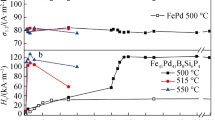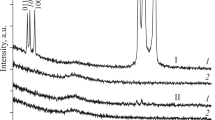Abstract
Fast-quenched ribbons with thicknesses of 200, 50, 30, and 20 μm have been obtained by melt spinning at hardening disk rotation speeds of 500, 1500, 2500, and 3500 rpm, respectively. The chemical composition of the ribbons has been determined by atomic emission spectroscopy on a Spectroflame Modula S spectrometer. X-ray diffraction patterns of the ribbons have obtained on a DRON-6 diffractometer (CuKα radiation) with a graphite monochromator. The effect of the melt cooling rate on the structural state of the contact and free sides of the Fe77Ni1Si9B13 alloy ribbons has been examined. It has been established that, by increasing the melt cooling rate, one can obtain fast-quenched Fe77Ni1Si9B13 alloy ribbons with different structures: X-ray amorphous at 3500, 2500, and 1500 rpm and crystalline at 500 rpm. Cooling of the melt at a quenching disk rotation speed of 500 rpm makes it possible to obtain Fe77Ni1Si9B13 alloy ribbons with crystallographic structures of three types: A2, C16, and D03 (A2 corresponds to the α-Fe(Si) phase; C16, to the Fe2B phase; and D03, to the Fe3Si phase). In the surface layers on the ribbon free side, texturing of the Fe3Si phase has been detected. It is noted that the crystal structure of the ribbons obtained by melt cooling on a quenching disk at a rotation speed of 500 rpm differs from the structure of the ribbons of this alloy crystallized from the amorphous state by annealing.




Similar content being viewed by others
REFERENCES
V. I. Betekhin, P. N. Butenko, A. G. Kadomtsev, V. E. Korsukov, M. M. Korsukova, B. A. Obidov, and O. V. Tolochko, Phys. Solid State 49 (12), 2223 (2007). https://doi.org/10.1134/S1063783407120025
N. A. Skulkina, O. A. Ivanov, E. A. Stepanova, L. N. Shubina, P. A. Kuznetsov, and A. K. Mazeeva, Phys. Procedia 82, 69 (2016) https://doi.org/10.1016/j.phpro.2016.05.013
E. V. Pustovalov, N. D. Zakharov, V. S. Plotnikov, and B. N. Grudin, Phys. Met. Metallogr. 97 (6), 626 (2004).
V. A. Volkov, V. I. Lad’yanov, and V. S. Tsepelev, Metally, No. 6, 37 (1998).
W. Fang, H. Guo-qi, Z. Peng-na, F. Tang-fu, W. Ya-juan, S. Ren-bing, and Z. Jian, Cryogenics 30, 103633 (2023). https://doi.org/10.1016/j.cryogenics.2023.103633
I. I. Danilova, V. V. Markin, O. V. Smolyakova, V. E. Ro-shchin, S. I. Il’in, and Yu. N. Goykhenberg, Vest. YuUrGU, Ser. Metallurgiya, No. 9, 16 (2008).
T. Tamura and M. Li. J. Alloys Comp. 826, 154010 (2020). https://doi.org/10.1016/j.jallcom.2020.154010
J. Mattson, E. Theisen, and P. Steen, Chem. Eng. Sci. 192, 1198 (2018). https://doi.org/10.1016/j.ces.2018.07.017
M. Nabialek, Arch. Metall. Mater. 61 (1), 439 (2016). https://doi.org/10.1515/amm-2016-0079
J. Li, H. Chen, S. Li, Q. Fang, Y. Liu, L. Liang, H. Wu, and P. K. Liaw, Mater. Sci. Eng.: A 760, 359 (2019). https://doi.org/10.1016/j.msea.2019.06.017
J. E. K. Schawe and J. F. Löffler, Nature Commun. 10, 1337 (2019). https://doi.org/10.1038/s41467-018-07930-3
A. Ya. Belen’kii and S. N. Zolotarev, Rasplavy, No. 4, 76 (1990).
C. T. Hu, T. Goryczka, and D. Vokoun, Scr. Mater. 50 (4), 539 (2004). https://doi.org/10.1016/j.scriptamat.2003.10.026
S. Madireddi, Eng. Sci. Technol. 23 (5), 1162 (2020). https://doi.org/10.1016/j.jestch.2020.02.003
V. F. Bashev, S. I. Ryabtsev, O. I. Kushnerov, N. A. Kutseva, and S. N. Antropov East.-Eur. J. Phys., No. 3, 81 (2020). https://doi.org/10.26565/2312-4334-2020-3-10
S. Madireddi, Mater. Today: Proc. 38 (5), 2532 (2021). https://doi.org/10.1016/j.matpr.2020.07.550
X. Cui, O. D. Zhang, X. Y. Li, and F. Q. Zu, J. Non-Cryst. Solids 452, 336 (2016), https://doi.org/10.1016/j.jnoncrysol.2016.09.015
S. Öztürk, S. E. Sünbül, and K. İcin, Trans. Nonferrous Met. Soc. China 30 (5), 1169 (2020). https://doi.org/10.1016/S1003-6326(20)65287-6
H. Gao, Z. Li, S. Zhou, G. Zhang, and N. T. Cui, Prog. Nat. Sci.: Mater. Int. 29 (5), 556 (2019). https://doi.org/10.1016/j.pnsc.2019.08.012
Y.-G. Su, F. Chen, C.-Y. Wu, M.-H. Chang, and C.-A. Chung, ISIJ Int. 55 (11), 2383 (2015). https://doi.org/10.2355/isijinternational.ISIJINT-2015-349
X. Cui, Q. D. Zhang, X. Y. Li, and F. Q. Zu, J. Non-Cryst. Solids 452, 336 (2016). https://doi.org/10.1016/j.jnoncrysol.2016.09.015
I. I. Usatyuk, I. A. Novokhatskii, and Yu. F. Kaverin, Metally, No. 2, 127 (1994).
V. V. Molokanov, M. I. Petrzhik, T. N. Mikhailova, V. P. Manov, P. S. Popel’, and V. E. Sidorov, Rasplavy, No. 4, 40 (2000).
G. V. Shishalova, M. A. Kulakova, and E. E. Varlashova, Anal. Kontrol 7 (2), 186 (2003).
A. A. Pupyshev and D. A. Danilova, Anal. Kontrol 11 (2-3), 131 (2007).
Rapidly Hardened Metals, Sb. Nauchn. Tr., Ed. by B. Kantor (Metallurgiya, Moscow, 1983) [in Russian].
D. N. Kharlamov, V. A. Volkov, V. I. Lad’yanov, and B. P. D’yakonov, Metally, No. 2, 196 (2002).
N. V. Ershov, Yu. P. Chernenkov, V. A. Lukshina, and V. I. Fedorov, Phys. Solid State 54 (9), 1935 (2012). https://doi.org/10.1134/S1063783412090107
ACKNOWLEDGMENTS
This study was carried out on the equipment of the Center for Collective Use “Surface and New Materials” of the Udmurt Federal Research Center, Ural Branch, Russian Academy of Sciences.
Funding
This study was carried out within the framework of research topic no. 121030100001-3.
Author information
Authors and Affiliations
Corresponding author
Ethics declarations
The authors of this work declare that they have no conflicts of interest.
Additional information
Translated by E. Bondareva
Publisher’s Note.
Pleiades Publishing remains neutral with regard to jurisdictional claims in published maps and institutional affiliations.
Rights and permissions
About this article
Cite this article
Lad’yanov, V.I., Konovalov, M.S., Mokrushina, M.I. et al. On the Effect of the Melt Cooling Rate upon Spinning on the Structure of the Surface Layers of Fe77Ni1Si9B13 Alloy Ribbons. Tech. Phys. Lett. (2024). https://doi.org/10.1134/S1063785024700184
Received:
Revised:
Accepted:
Published:
DOI: https://doi.org/10.1134/S1063785024700184




